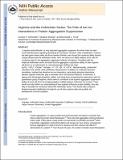Arginine and the Hofmeister Series: The Role of Ion–Ion Interactions in Protein Aggregation Suppression
Author(s)
Schneider, Curtiss P.; Shukla, Diwakar; Trout, Bernhardt L.
DownloadTrout_Arginine hofmeister.pdf (1.917Mb)
PUBLISHER_POLICY
Publisher Policy
Article is made available in accordance with the publisher's policy and may be subject to US copyright law. Please refer to the publisher's site for terms of use.
Terms of use
Metadata
Show full item recordAbstract
L-Arginine hydrochloride is a very important aggregation suppressor for which there has been much attention given regarding elucidating its mechanism of action. Little consideration, however, has been given toward other salt forms besides chloride, even though the counterion likely imparts a large influence per the Hofmeister Series. Here, we report an in depth analysis of the role the counterion plays in the aggregation suppression behavior of arginine. Consistent with the empirical Hofmeister series, we found that the aggregation suppression ability of other arginine salt forms on a model protein (α-chymotrypsinogen) follows the order: H[subscript 2]PO[subscript 4][superscript –] > SO[subscript 4][superscript 2–] > citratep[superscript 2–] > acetate[superscript –] ≈ F[superscript –] ≈ Cl[superscript –] > Br[superscript –] > I[superscript –] ≈ SCN[superscript –]. Mechanistically, preferential interaction and osmotic virial coefficient measurements, in addition to molecular dynamics simulations, indicate that attractive ion–ion interactions, particularly attractive interactions between arginine molecules, play a dominate role in the observed behavior. Furthermore, it appears that dihydrogen phosphate, sulfate, and citrate have strong attractive interactions with the guanidinium group of arginine, which seems to contribute to the superior aggregation suppression ability of those salt forms by bridging together multiple arginine molecules into clusters. These results not only further our understanding of how arginine influences protein stability, they also help to elucidate the mechanism behind the Hofmeister Series. This should help to improve biopharmaceutical stabilization through the use of other arginine salts and possibly, the development of novel excipients.
Description
Author Manuscript date 2012 June 9
Date issued
2011-06Department
Massachusetts Institute of Technology. Department of Chemical EngineeringJournal
The Journal of Physical Chemistry B
Publisher
American Chemical Society (ACS)
Citation
Schneider, Curtiss P., Diwakar Shukla, and Bernhardt L. Trout. Arginine and the Hofmeister Series: The Role of Ion–Ion Interactions in Protein Aggregation Suppression. The Journal of Physical Chemistry B 115, no. 22 (June 9, 2011): 7447-7458.
Version: Author's final manuscript
ISSN
1520-6106
1520-5207